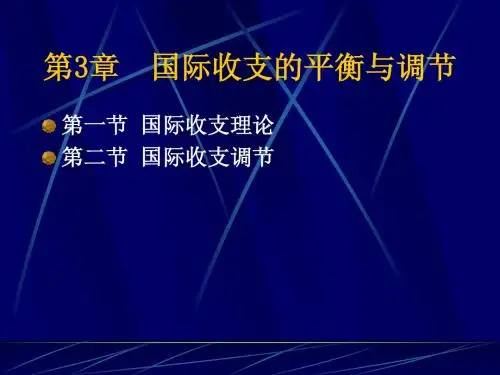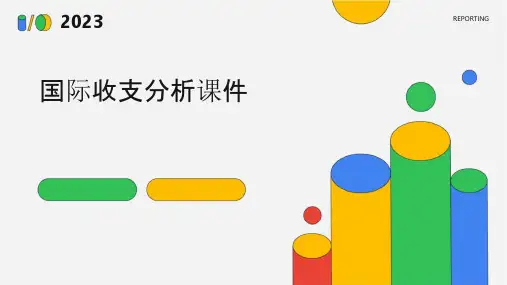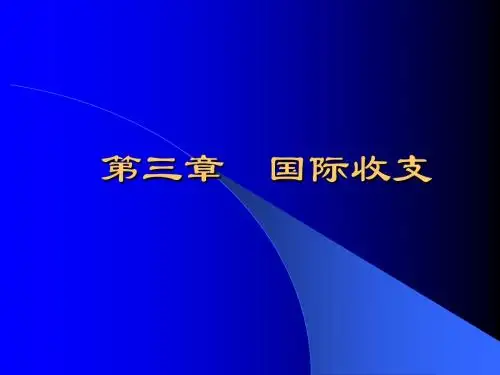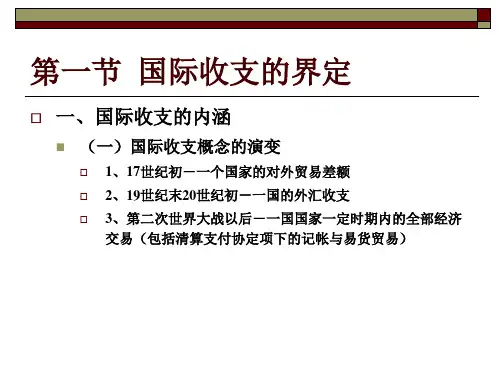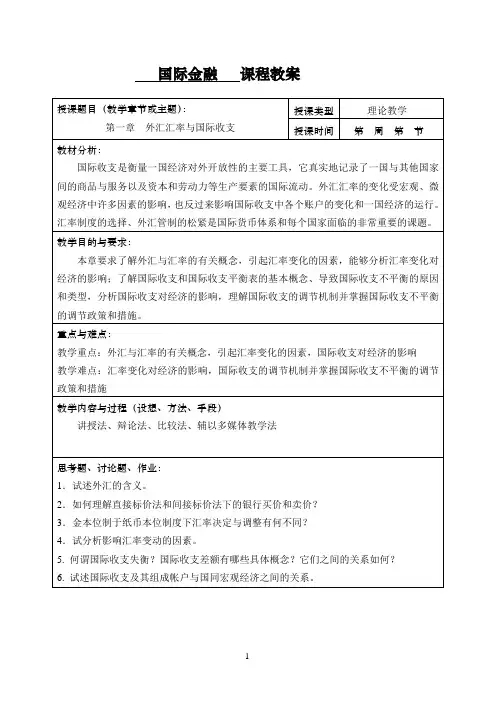第三章国际收支
- 格式:ppt
- 大小:157.50 KB
- 文档页数:74
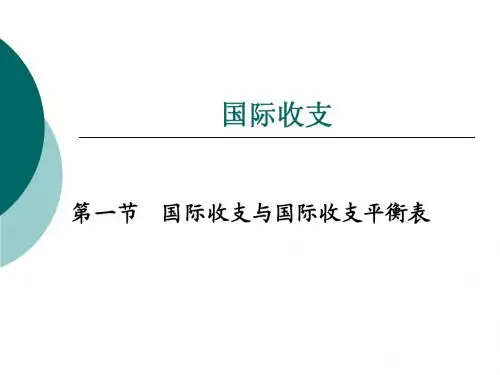
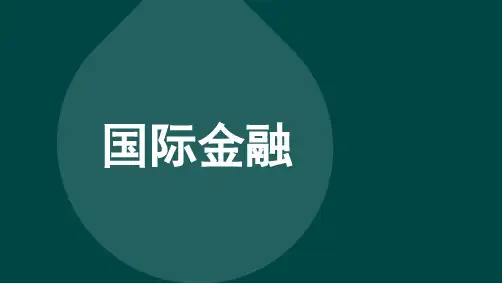
第二章国际储备第三章第四章外汇实务第五章第六章第七章第八章国际结算第九章第十章第十一章重点重点重难点重点难点重点重难点第一章国际收支本章重难点分析第一节国际收支与国际收支平衡表一、国际收支1(1(2(3第一节国际收支与国际收支平衡表一、国际收支广义的国际收支是指一个经济体居民与非居民之间发生的所有经济交易活动的汇总。
它以交易为基础,不仅包括贸易收支和非贸易收支,也包括资本的输入和输出;不仅包括已实现的外汇收支交易,也包括未实现的外汇收支交易。
国际货币基金组织建议采用广义的国际收支概念。
一、国际收支2(1(2一、国际收支2(3二、国际收支平衡表二、国际收支平衡表1二、国际收支平衡表二、国际收支平衡表23二、国际收支平衡表4第一节国际收支与国际收支平衡表三、国际收支平衡表的结构(1)经常账户,包括货物、服务、初次收入和二次收入四个子账户。
(2)资本与金融账户,包括资本账户和金融账户两个子账户。
(3)误差与遗漏净额是作为残差项推算的,于轧平账户时使用。
四、国际收支平衡表的内容四、国际收支平衡表的内容1.(1(212个四、国际收支平衡表的内容2.3.四、国际收支平衡表的内容四、国际收支平衡表的内容1.(1(2四、国际收支平衡表的内容2.(1(2(3四、国际收支平衡表的内容(4(5四、国际收支平衡表的内容讲解归纳与举例)A. B./处置C. D.【正确答案:B】/谢谢第二节国际收支平衡表的分析一、分析国际收支平衡表的意义(1(2(3一、分析国际收支平衡表的意义(1(2(3二、国际收支平衡表分析方法(三种)二、国际收支平衡表分析方法(三种)1.二、国际收支平衡表分析方法(三种)2.二、国际收支平衡表分析方法(三种)3./ 4.二、国际收支平衡表分析方法(三种)二、国际收支平衡表分析方法(三种)三、国际投资头寸表三、国际投资头寸表三、国际投资头寸表1.2.三、国际投资头寸表3.4.三、国际投资头寸表5.(1(2(3(4讲解归纳与举例A. B.C. D.【正确答案:B】谢谢第三节国际收支的调节一、国际收支平衡表的平衡与失衡一、国际收支平衡表的平衡与失衡二、国际收支失衡的原因二、国际收支失衡的原因三、国际收支失衡的经济影响(1(2(3(4(1(2四、国际收支调节方法四、国际收支调节方法1.四、国际收支调节方法2.。
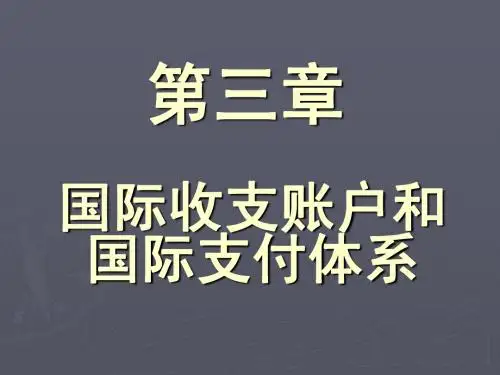

C HAPTER 3T HE B ALANCE OF P AYMENTS1. Balance of Payments Defined. What is the balance of payments?The measurement of all international economic transactions between the residents of a country and foreign residents is called the balance of payments (BOP).2. BOP Data. When central banks publish data about BOP, what other analytical data do central bankspresent?Central banks are responsible for managing their countries’ balance of payments. Central banksperiodically publish data about the performance of the BOP. In addition to its importance topolicymakers, this data can provide some important signals for MNEs and foreign investors. Central bankers have to provide analysis of the reasons behind persistent deficits/surpluses in the current account. Central banks have also to explain the methods by which they solve the deficits or surpluses (through foreign debt, drawing on foreign reserves or transfers). Central banks may also mention impending or future policies that they may fo llow, such as changes in the country’s foreign exchange rate.3. Importance of BOP. Business managers and investors need BOP data to anticipate changes in hostcountry economic policies that might be driven by BOP events. From the perspective of business managers and investors, list three specific signals that a country’s BOP data can provide.▪The BOP is an important indicator of pressure on a country’s foreign exchange rate and thus on the potential for a firm trading with or investing in that country to experience foreign exchangegains or losses. Changes in the BOP may predict the imposition or removal of foreign exchangecontrols.▪Changes in a country’s BOP may signal the imposition or removal of controls over payment of dividends and interest, license fees, royalty fees, or other cash disbursements to foreign firms orinvestors.▪The BOP helps to forecast a country’s market potential, especially in the short run. A country experiencing a serious trade deficit is not likely to expand imports as it would if running a surplus.It may, however, welcome investments that increase its exports.4. Managing BOP Deficits. How does a central bank manage BOP deficits?BOP accounting uses a double-entry accounting system, where debits and credits must theoretically correspond or balance out; that is, current account transactions must be cancelled out by capital and financial account transactions. But in reality, many factors make this impossible. For one thing,fluctuations in exchange rates make inflow and outflow transactions change value, causing excess payments or receipts during the one-year period. Moreover, temporary periods of recession could cause a slowdown in exports. Another reason for a temporary BOP imbalance may be because of the importation of capital goods and inputs to serve an industrial or construction boom. In short, BOPdeficits are not necessarily a bad phenomenon in their own right, but must be analyzed within the broader macroeconomic picture.5. Economic Activity. What data can a nation’s BOP provide about a country’s economy?Reading through the BOP can provide detailed information about the performance of the country on international markets and the economic competitiveness of its forms. If a country is experiencing recurrent current account deficits, this may be an indication of the lack of competitiveness of the country’s industries. Recurrent capital account deficits may signal increasing public expenditures and fiscal budget deficits. It can also signal protectionist policies that the government may be following.6. Balance. If the BOP always “balances,” then how do countries run a BOP deficit or surplus?The cumulative international economic transactions of the BOP should balance. These include the three main component accounts: current account, capital account, and financial account, in addition to the statistical discrepancies and official reserves. But each of the three component accounts can either show a deficit or a surplus. Countries run BOP deficits when their outflows are higher than their inflows and vice versa. A BOP deficit can be supported by drawing on reserve holdings or byborrowing from abroad. Conversely, an overall BOP surplus is absorbed by adding to the central bank’s reserve holdings or by making foreign loans.7. Official Reserve Account. Why does the central bank of a nation hold official reserve assets? Whatare its major components?Official reserve assets are financial assets held by monetary authorities such as central banks. These should be highly liquid assets in the form of foreign currencies, gold, precious metals, specialdrawing rights (SDRs), and reserve positions with the IMF. The most important foreign currency reserves are the US dollar and the euro, followed by the British pound and the Japanese yen. Official reserves are used as international means of payments to finance trade imbalances, determine the exchange rate of the domestic currency, and influence the money supply.8. Current Account Surpluses. Explain the main causes behind the current account surpluses thatAsian emerging economies have maintained during the last two decades.Asian emerging economies have maintained a current account surpluses for the last two or three decades. This is mainly due to the fact that their economic growth strategies are dependent onexport-oriented policies. These policies include a devaluated domestic currency that provides more competitiveness for local industries and restricts imports. At the same time, the relatively closed nature of Asian emerging ma rkets hampers foreigners’ exports. These protectionist policies have created a continuous current account surplus. But it may not be favorable to maintain in the long-run since they will eventually lead to exchange rate appreciation and deterioration in the terms of trade.9. BOP Accounting Deficits. BOP Accounting Deficits. A deficit in the BOP is not necessarily a badthing, but must be analyzed in relation to the business cycle and economy. Explain.BOP deficits arise when the total level of outflows exceeds inflows. In the short run, central banks take out loans in order to make the BOP balance out. But long-term remedies to correct a balance of payment disequilibrium lies in adopting monetary, institutional, and fiscal policy changes to earn more foreign exchange from boosting exports and/or reducing imports.10. Current Account. Is the current account the same as the balance of trade (BOT)? Give debit andcredit examples of current account and BOT transactions by a German automobile MNE.The current account is one of the sub-component accounts of the BOP. It comprises the goods trade account (exports and imports of tangible goods); services trade account (exports and imports of intangible services); income account (current investment income as well as wages/salaries of non-resident workers; and current transfers account (personal or corporate financial settlements and inter-country gift and grant transfers. The largest sub-account of the current account is the Balance of Trade (BOT), which makes up the goods and services trade balances. It is generally the most quoted of all BOP accounts.The following are examples of transactions of an automobile MNE headquartered in Germany and operating in many countries.11. Negative Net International Investment Position. What does a country’s consistent nega tive netinternational investment position indicate?The net international investment position (NIIP) is the difference between the accumulated stock of the country’s claims on foreigners and the accumulated stock of foreign claims on domestic residents.The NIIP can be thought of as a nation’s international balance sheet. The accumulated stock and liabilities include assets such as shares, bonds, private assets, direct investment (such as subsidiaries and branches in foreign countries), bank loans, trade credits, official reserve assets, and government assets (such as foreign treasury bills).When claims of foreigners on the country are greater than domestic claims on foreigners, thisrepresents the net foreign indebtedness of the country. One reason for this deficit is foreignborrowings, mainly to service debts or to finance current account deficits. Another reason could be that domestic investors prefer to include foreign financial instruments in their portfolio because of higher rates of return on assets held abroad in comparison to domestic rates of return. Negative NIIP could be the result of fluctuations in asset prices and/or exchange rates.12. BOP and foreign exchange. The Swiss franc was officially unpegged from the euro in January 2015.Explain the reason behind this decision with reference to the Swiss BOP.The Swiss National Bank (SNB) pegged the Swiss franc against the euro in 2011 amid shaky global financial markets. Exports had already boomed, making up almost 70% of GDP. As the currentaccount enjoyed a substantial surplus, the SNB accumulated massive foreign reserves. As the euro kept weakening due to the sovereign debt problems of Greece and Spain, the franc automatically depreciated, raising alarm bells that it would no longer be a safe and stable currency. In response, the SNB decided to unpeg the franc, causing an instant appreciation. The stronger franc will help reduce the current account surplus.13. Classifying Transactions. Classify the following as a transaction reported in a sub-component of thecurrent account or the capital and financial accounts of the two countries involved:a. A U.S. food chain imports wine from Chile. Debit to U.S. goods part of current account, credit toChilean goods part of current account.b. A U.S. resident purchases a euro-denominated bond from a German company. Debit to U.S.portfolio part of financial account; credit to German portfolio of financial account.c. Singaporean parents pay for their daughter to study at a U.S. university. Credit to U.S. currenttransfers in current account; debit to Singapore current transfers in current account.d. A U.S. university gives a tuition grant to a foreign student from Singapore. If the student isalready in the United States, no entry will appear in the balance of payments because payment is between U.S. residents. (A student already in the United States becomes a resident for balance of payments purposes.)e. A British Company imports Spanish oranges, paying with eurodollars on deposit in London. Adebit to the goods part of Britain’s current account; a credit to the goods part of Spain’s currentaccount.f. The Spanish orchard deposits half the proceeds in a eurodollar account in London. No recordingin the U.S. balance of payments, as the transaction was between foreigners using dollars already deposited abroad. A debit to the income receipts/payments of the British current account; a credit to the income receipts/payments of the Spanish current account.g. A London-based insurance company buys U.S. corporate bonds for its investment portfolio. Adebit to the portfolio investment section of the British financial accounts; a credit to the portfolio investment section of the U.S. balance of payments.h. An American multinational enterprise buys insurance from a London insurance broker. A debit tothe services part of the U.S. current account; a credit to the services part of the British currentaccount.i. A London insurance firm pays for losses incurred in the United States because of an internationalterrorist attack. A debit to the services part of the British current account; a credit to the services part of the U.S. current account.j. Cathay Pacific Airlines buys jet fuel at Los Angeles International Airport so it can fly the return segment of a flight back to Hong Kong. Hong Kong keeps its balance of payments separate from those of the People’s Republic of China. Hence a debit to the goods part of Hong Kong’s current account; a credit to the goods part of the U.S. current account.k. A California-based mutual fund buys shares of stock on the Tokyo and London stock exchanges.A debit to the portfolio investment section of the U.S. financial account; a credit to the portfolioinvestment section of the Japanese and British financial accounts.l. The U.S. army buys food for its troops in South Asia from vendors in Thailand. A debit to the goods part of the U.S. current account; a credit to the goods part of the Thai current account.m. A Yale graduate gets a job with the International Committee of the Red Cross working in Bosnia and is paid in Swiss francs. A debit to the income part of the Swiss current account; a credit to the income part of the Bosnia current account. This assumes the Yale graduate spends her earnings within Bosnia; should she deposit the sum in the United States, then the credit would be to the income part of the U.S. current account.n. The Russian government hires a Dutch salvage firm to raise a sunken submarine. A debit to the service part of Russia’s current account; a credit to the service part of the Netherlands’s current account.o. A Colombian drug cartel smuggles cocaine into the United States, receives a suitcase of cash, and flies back to Colombia with that cash. This would not get captured in the goods part of the U.S. or Colombian current accounts. Assuming the cash was “laundered” appropriately, from the point of view of the smugglers, bank accounts in the United States or somewhere else (probably notColombia, possibly Switzerland) would be credited. This imbalance would end up in the errors and omissions part of the U.S. balance of payments.p. The U.S. government pays the salary of a Foreign Service Officer working in the U.S. embassy in Beirut. Diplomats serving in a foreign country are regarded as residents of their home country, so this payment would not be recorded in any balance of payments accounts. If or when the diplomat spent the money in Beirut, at that time a debit should be incurred in the goods or services part of the U.S. current account and a contrary entry in the Lebanon balance of payments. It is doubtful that the goods or services transaction would get reported or recorded, although on a net basis changes in bank balances would reflect half of the transaction.q. A Norwegian shipping firm pays U.S. dollars to the Egyptian government for passage of a ship through the Suez Canal. If the Norwegian firm paid with dollar balances held in the United States and the Suez Canal Authority of Egypt redeposited the proceeds in the United States, no entry would appear in the U.S. balance of payments. Norway would debit a purchase of services, and Egypt would credit a sale of services.r. A German automobile firm pays the salary of its executive working for a subsidiary in Detroit.Germany would record a debit in the income payments/receipts in its current account; the U.S.would record a credit in the income payments/receipts in its current account.s. An American tourist pays for a hotel in Paris with his American Express card. A debit would be recorded in the services part of the U.S. current account; a credit would be recorded in theservices part of the French current account.t. A French tourist from the provinces pays for a hotel in Paris with his American Express card. A French resident most likely has a French-issued credit card, issued by the French subsidiary of American Express. In this instance, no entry would appear in either country’s balance ofpayments. If, later, the French subsidiary of American Express paid a dividend back to the United States, that would be recorded in the income part of the current accounts.u. A U.S. professor goes abroad for a year and lives on a Fulbright grant. The current transfers section of the U.S. current account would be debited for the salary paid to a foreign resident.(Even though an American, the professor is a foreign resident during the time he lives abroad.) The current transfers section of the host country’s current account would be credited.14. Current Account Deficits. A deficit on the current account increases foreign liabilities. Explain whythis is more of a concern to the Eurozone than a country like Brazil.Brazil is one of the fastest growing emerging market economies. It is a newly industrialized nation where a substantial volume of its imports consists of inputs and intermediate goods needed formanufacturing. This results in a deficit in its current account. This is of little concern to Brazil since it anticipates continuous GDP growth as well as future growth of its exports. In order to restore its competitiveness on international markets, the Brazilian government occasionally resorts to devaluing the Brazilian real. On the other hand, the Eurozone’s current account deficits are causing highconcerns. One reason is that these economies have been growing at sluggish rates since the financial meltdown. Also, since Eurozone countries have a common currency, they are unable to individually devalue the euro to restore their competitiveness.15. Twin Surpluses. Why is China’s twin surpluses—a surplus in both the current and financialaccounts—considered unusual?China’s surpluses in both the current and financial accounts—termed the twin surplus in the business press—is highly unusual. Ordinarily, countries experiencing large current account deficits fund these deficits through equally large surpluses in the financial account, and vice versa.China has experienced a massive current account surplus and a sometimes sizable financial account surplus simultaneously. This is rare and an indicator of just how exceptional the growth of theChinese economy has been. Although current account surpluses of this magnitude would ordinarily create a financial account deficit, the positive prospects of the Chinese economy have drawn such massive capital inflows into China in recent years that the financial account too is in surplus.16. Treasury bonds. After the Global Financial Crisis especially sovereign and portfolio investors fromemerging market economies have purchased significant volumes of European treasury bonds. Discuss the impact on the European BOPs in both the short run and the long run.As foreigners purchase European treasury bonds, European BOP will improve in the short run. But in the long run, the BOP may deteriorate because European nations should make interest and principal payments to foreigners. However, if the European governments use these funds prudently andproductively, the long-term effect would be favorable to GDP and may even contribute to European firms’ competit iveness, eventually leading to long-run BOP improvements.17. Capital Mobility — The Eurozone. Low interest rates should normally lead to capital outflows toother countries and currencies in the search for higher interest rates. Explain why the opposite has occurred in the Eurozone.In spite of the remarkably low interest rates paid by the euro, capital has not flowed out of the Euro zone. In fact, the opposite has occurred as a result of high levels of productive innovation andperceived political stability. Moreover, the advanced level of financial services, technology,infrastructure and purchasing power are attractive to investors. All of these factors have made the Euro zone an attractive investment hub.18. BOP Transactions. Identify the correct BOP account for each of the following transactions.a. A German-based pension fund buys U.S. government 30-year bonds for its investment portfolio.Financial account: portfolio investment liabilitiesb. Scandinavian Airlines System (SAS) buys jet fuel at Newark Airport for its flight to Copenhagen.Current account: Goods: Exports FOBc. Hong Kong students pay tuition to the University of California, Berkeley.Current account: Services: creditd. The U.S. Air Force buys food in South Korea to supply is air crews.Current account: Goods: Importse. A Japanese auto company pays the salaries of its executives working for its U.S. subsidiaries.Current account: Services: creditf. A U.S. tourist pays for a restaurant meal in Bangkok.Current account: Services: debitg. A Colombian citizen smuggles cocaine into the United States, receives cash, and smuggles thedollars back into Colombia.Unrecorded but should be a current account item.h. A U.K. corporation purchases a euro-denominated bond from an Italian MNE.Does not enter the U.S. balance of payments19. BOP and Inflation. What are the direct and indirect relationships between the balance of paymentsand inflation?The current account and the level of imports have the potential to lo wer or raise a country’s inflation rate. If the inflation rate in the exporting country rises, then imported inflation will result. Moreover, if the domestic currency devalues, imported goods and services will become more expensive. On the other hand, imports of cheaper goods and services place pressures on domestic competitors to reduce the prices of comparable goods and services. Thus, the components and price levels of the imports (as appearing on the current account) can substantially impact prices, especially in import-orientedeconomies.20. J-Curve Dynamics. What is the J-Curve adjustment path?A country’s trade balance may change as a result of an exchange rate change in the shape of aflattened “j.” International economic analysis characterizes the trade balance adjustment process as occurring in three stages: (1) the currency contract period, (2) the pass-through period, and (3) the quantity adjustment period. Assuming that the trade balance is already in deficit prior to thedevaluation, a devaluation may actually result in the trade balance first worsening before improving as a result of the three distinct commercial periods.21. Pass Through. Explain the exchange rate pass through and whether it always holds true.Exchange rate pass through indicates the degree to which importers and exporters adjust the prices of goods and services according to exchange rate changes. Theoretical research such as the theory of PPP stipulates that all exchange rate changes are passed through by equivalent changes in prices to trading partners. However, empirical research has challenged this long-held postulation. For example, the sizable current account deficits of the United States and some European nations in the 1980s and 1990s did not show responses to changes in the exchange rate values.22. Restrictions on Capital Mobility. What factors seem to play a role in a government’s choice torestrict capital mobility?There is a spectrum of motivations for capital controls, with most associated with either insulating the domestic monetary and financial economy from outside markets or political motivations overownership and access interests. Capital controls are just as likely to occur over capital inflows as they are over capital outflows. Although there is a tendency for a negative connotation to accompany capital controls (possibly the bias of the word “control” itself), the impossible trinity requires that capital flows be controlled if a country wishes to maintain a fixed exchange rate and an independent monetary policy.23. Dutch Disease. Can controls of capital inflow solve the Dutch Disease in resource-rich countries?The economies of resource-rich countries can suffer from serious problems in the case of excessive capital inflows. In freely floating foreign exchange systems, massive capital inflows can lead toconsiderable currency appreciation. This phenomenon has come to be known as the Dutch Disease as it was first witnessed by the Netherlands in the 1970s after the discovery of the Groningen natural gas field. A stronger domestic currency may harm exporters as it lowers price competitiveness. Many oil-rich nations in Africa and Asia that have export sectors suffer from this problem. To tackle thisproblem, the government can place restrictions and controls on capital inflows. Another solution that some Gulf nations in the Arab peninsula resort to is to peg their currencies.24. Globalization and Capital Mobility. How does capital mobility typically differ betweenindustrialized countries and emerging market countries?Emerging market countries, by definition, have relatively small and undeveloped financial systems and sectors. Outside of some potential foreign direct investment opportunities, they offer few choices for capital to flow in of substance. Industrialized countries, however, typically have large andsophisticated financial sectors that offer a multitude of financial investment options and assets, which on occasion may attract large capital inflows (and in other periods, may suffer large capital outflows).。
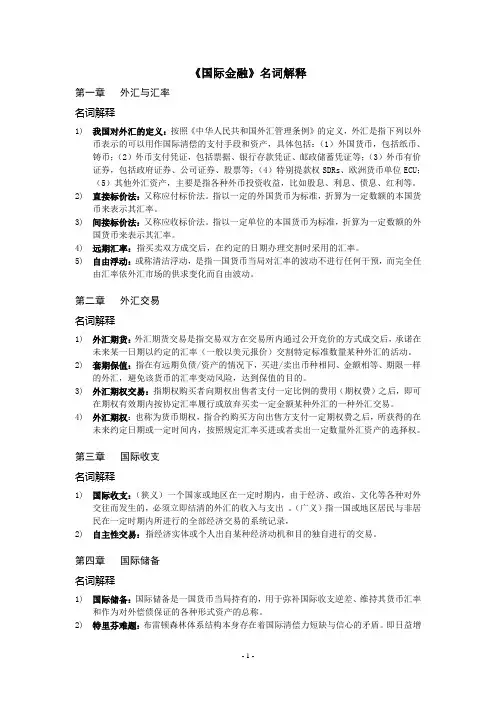
《国际金融》名词解释第一章外汇与汇率名词解释1)我国对外汇的定义:按照《中华人民共和国外汇管理条例》的定义,外汇是指下列以外币表示的可以用作国际清偿的支付手段和资产,具体包括:(1)外国货币,包括纸币、铸币;(2)外币支付凭证,包括票据、银行存款凭证、邮政储蓄凭证等;(3)外币有价证券,包括政府证券、公司证券、股票等;(4)特别提款权SDRs、欧洲货币单位ECU;(5)其他外汇资产,主要是指各种外币投资收益,比如股息、利息、债息、红利等。
2)直接标价法:又称应付标价法。
指以一定的外国货币为标准,折算为一定数额的本国货币来表示其汇率。
3)间接标价法:又称应收标价法。
指以一定单位的本国货币为标准,折算为一定数额的外国货币来表示其汇率。
4)远期汇率:指买卖双方成交后,在约定的日期办理交割时采用的汇率。
5)自由浮动:或称清洁浮动,是指一国货币当局对汇率的波动不进行任何干预,而完全任由汇率依外汇市场的供求变化而自由波动。
第二章外汇交易名词解释1)外汇期货:外汇期货交易是指交易双方在交易所内通过公开竞价的方式成交后,承诺在未来某一日期以约定的汇率(一般以美元报价)交割特定标准数量某种外汇的活动。
2)套期保值:指在有远期负债/资产的情况下,买进/卖出币种相同、金额相等、期限一样的外汇,避免该货币的汇率变动风险,达到保值的目的。
3)外汇期权交易:指期权购买者向期权出售者支付一定比例的费用(期权费)之后,即可在期权有效期内按协定汇率履行或放弃买卖一定金额某种外汇的一种外汇交易。
4)外汇期权:也称为货币期权,指合约购买方向出售方支付一定期权费之后,所获得的在未来约定日期或一定时间内,按照规定汇率买进或者卖出一定数量外汇资产的选择权。
第三章国际收支名词解释1)国际收支:(狭义)一个国家或地区在一定时期内,由于经济、政治、文化等各种对外交往而发生的,必须立即结清的外汇的收入与支出。
(广义)指一国或地区居民与非居民在一定时期内所进行的全部经济交易的系统记录,2)自主性交易:指经济实体或个人出自某种经济动机和目的独自进行的交易。
